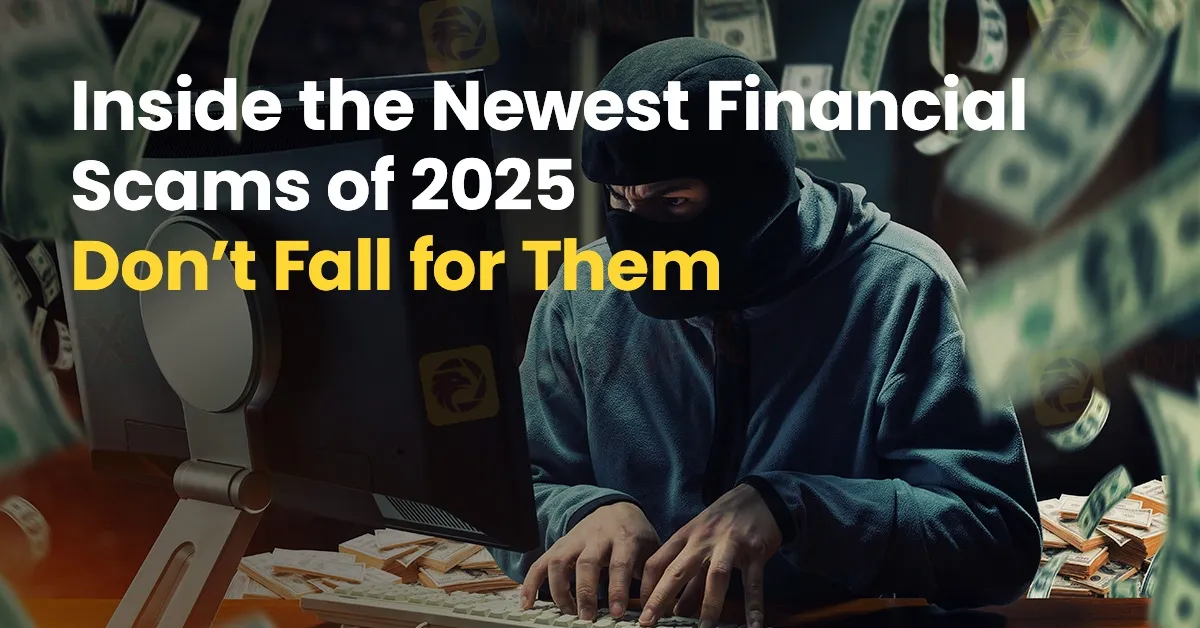Inside the Newest Financial Scams of 2025 | Don’t Fall for Them
Abstract:The financial landscape in 2025 is more sophisticated than ever, but so are the scams designed to exploit traders, investors, and everyday consumers. With advancements in artificial intelligence, deepfake technology, and decentralised finance (DeFi), fraudsters have found new ways to deceive even the most cautious individuals. From AI-powered Ponzi schemes to fraudulent trading platforms, here are the most commonly seen scams of 2025 and how you can protect yourself.

The financial landscape in 2025 is more sophisticated than ever, but so are the scams designed to exploit traders, investors, and everyday consumers. With advancements in artificial intelligence, deepfake technology, and decentralised finance (DeFi), fraudsters have found new ways to deceive even the most cautious individuals. From AI-powered Ponzi schemes to fraudulent trading platforms, here are the most commonly seen scams of 2025 and how you can protect yourself.

Ponzi schemes are nothing new, but in 2025, they have evolved with AI-generated trading bots that claim to deliver guaranteed profits. Fraudsters lure victims by showcasing ‘successful’ automated trades, using deepfake videos of well-known financial experts endorsing their schemes. The reality? These bots often do nothing more than shuffle money between accounts before the scam collapses. Always verify a platforms legitimacy through regulatory bodies before investing.

The rise of AI chatbots has allowed scammers to create highly convincing fraudulent brokerages. Unlike traditional scams that rely on high-pressure sales tactics from human representatives, AI-driven scam brokers can engage with victims 24/7, using sophisticated natural language processing to gain their trust. They promise zero commissions, high leverage, and ‘exclusive’ investment opportunities—only for traders to realise too late that withdrawals are impossible. Checking for regulatory licensing and user reviews on independent financial watchdog websites remains crucial.

Social media remains a breeding ground for scams, but in 2025, deepfake technology has taken fraud to another level. Scammers now create highly realistic AI-generated videos of famous financial figures promoting fake investment opportunities. Whether its a billionaire investor seemingly backing a new crypto token or a respected economist recommending a dubious forex platform, these scams are becoming alarmingly convincing. Before taking any financial advice, verify its source through reputable channels.

The world of DeFi remains a hotbed for innovation—and exploitation. In 2025, scammers are launching DeFi projects that appear legitimate, attracting investors with promises of high-yield returns. Once enough money is pooled into the project, the developers suddenly withdraw all liquidity, leaving investors with worthless tokens. With DeFi operating outside traditional regulatory frameworks, due diligence is essential. Investigating a projects smart contract audits, team background, and community engagement can help avoid falling victim to such schemes.

As more countries roll out Central Bank Digital Currencies (CBDCs), scammers are taking advantage of public confusion. Fake websites and phishing emails now mimic official government portals, tricking users into ‘registering’ for early access to digital currencies. These scams often lead to identity theft and financial losses. To stay safe, always rely on official government websites and announcements regarding digital currency adoption.

In summary, the scams of 2025 are more deceptive and technologically advanced than ever before, making vigilance a necessity rather than an option. Whether through AI-generated fraud, deepfake deception, or crypto-based scams, fraudsters continue to refine their methods. Staying informed, verifying sources, and conducting thorough due diligence remain the best defences against financial scams. As technology evolves, so too must our ability to detect and avoid fraudulent schemes. To prevent falling victim to fraudulent schemes, using tools like WikiFX can be a game-changer. WikiFX provides detailed information on brokers, including regulatory status, customer reviews, and safety ratings, allowing users to verify the legitimacy of any investment platform before committing their money. With access to in-depth insights and risk alerts, WikiFX equips potential investors with the resources to make informed decisions and avoid unauthorised or unlicensed entities. By checking with WikiFX, users can confidently protect their savings and avoid the costly traps set by unscrupulous investment syndicates.

Read more

Rising Fraud in the Philippines: How BSP Circular 1140 and AI Combat Scams
Discover how the Philippines tackles rising fraud with BSP Circular 1140, AI-driven solutions, and tokenization to secure its digital economy. Learn more.

Pi Network Mainnet Launch: Game-Changer or Crypto Controversy?
Pi Network’s Mainnet launch sparks debate. With 100M users, KYC compliance, and Binance listing rumors, will it redefine crypto accessibility?

Coinbase Urges US Lawmakers to Establish Clear Crypto Regulations
Coinbase calls for clear US crypto regulations to foster innovation, protect consumers, and ensure transparency in the digital asset industry.

Danger Alert: Moroccan Trader Losing Money Due to GlobTFX Platform Crash!
In another incident confirming the suspicious practices of the GlobTFX platform, a trader from Morocco lost $89 while executing a financial trade due to a sudden technical failure on the platform.
WikiFX Broker
Latest News
Forex Inflows Surge by 245.9%, What’s Behind This Staggering Growth?
SaracenMarkets- Safe or Scam?
How to Spot a Fake Forex Broker Before You Lose Money
AUSTRAC Shakes Up Australia’s Crypto and Money Transfer Industries
Is Binance Really for Sale? The Truth Behind the Speculation and Market Shifts
Broker Comparison: XM vs AvaTrade
FCA Flags 9 Unlicensed Financial Website: Warning on Investor Risks
"I can't log in or withdraw funds"- Victim Said
Will SOLANA Survive the Meme Coin Collapse?
Cyprus Police Warn of Rising SMS Scams Targeting Binance Crypto Users
Rate Calc

